Amonkhet might be one of the best-designed Limited formats of all time.
I do not say this lightly. The last few years have been decent for draft, but no sets since Khans of Tarkir have been particularly dear to me. However, Amonkhet has a swath of components which I believe make for excellent Limited.
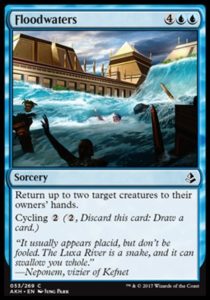
Flood Protection
Mana sink mechanics give players use for their mana in both the early and late game. They ensure that players have possible actions at all stages of the game and more consistently heave meaningful choices. Recently, Kaladesh had zero mechanics which protected against flood (which we covered back in September). Amonkhet bucks this trend and has two completely different mana sink mechanics: cycling and embalm.
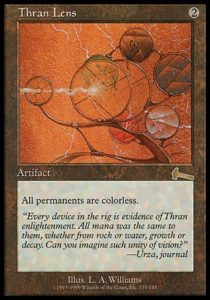
Lenticular Design
Lenticular design, a term coined by Mark Rosewater, is design that has hidden complexity which is apparent only to more experienced players. Lenticular design allows Magic to both be approachable to newer players while remaining challenging to professionals. A classic example of lenticular design is a creature with a death trigger: beginners won’t worry about that text until the creature dies, treating it as a happy bonus, while more experienced players will anticipate their creature’s death and possibly sacrifice the creature themselves to trigger the effect.
Amonkhet is full of both individual cards and entire mechanics which are both simple on their front sides but deeply complicated in their ideal use. When do you exert Emberhorn Minotaur or attack normally? Do you cycle that Lay Claim while you have five mana or hold it? Do you wait to embalm Sacred Cat in order to combine it with Binding Mummy or play it now to have another attacker? The cartouche/trial interactions are integral to those with eyes for them, but happy bonuses to those who don’t. Amonkhet is brimming with complexity, but so much of it is hidden beneath the surface.
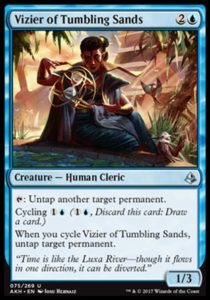
Shenanigans
Having exciting and unique things to do is a hallmark of sweet formats. Innistrad’s infamous Spider Spawning/pile of awful cards deck and Modern Masters 2013’s Dampen Thought deck are two unique decks which contribute to make them among the best Limited formats in my book.
Amonkhet has shenanigans and interactions aplenty, be it cycling cards for value with Ruthless Sniper, untapping exerted creatures to abuse their abilities, aggressively discarding to power up your heckbent cards like Thresher Lizard, swarming your opponent with zombie interactions, abusing spells in your graveyard, or just grinding tons of value by recurring cycling cards with Wander in Death or Sacred Excavation. Amonkhet has a slew of sweet and diverse shenanigans, and that’s a wondrous thing.
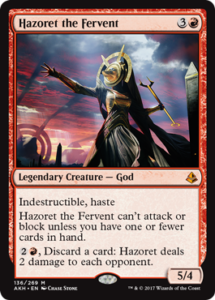
Generally Balanced Rares
Amonkhet generally threads the needle in terms of its rares. Many of them are powerful, but not back-breaking in practically all situations (the way that so many Scars of Mirrodin and Fate Reforged rares were). Higher rarity cards should be powerful: they give less experienced players an edge, they distinguish one deck from another, and they open up new lines and styles of play. Formats are best when there are strong rares, but most of them don’t just win the game automatically and are nearly impossible to answer.
The rares of Amonkhet seem to heavily fit into this category. The gods all die to multiple common removal spells. None of the planeswalkers is as unbeatable as Elspeth, Sun’s Champion (though all of them are quite strong). Sure, Glorybringer is broken in half, but there’s got to be some insane bombs as long as a large minority of them aren’t that strong.
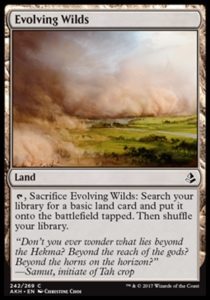
Reasonable fixing and rewards
Fixing is great. In small doses, it can allow the dedicated drafter to expand to a third color and attempt a more greedy archetype. In large doses, everyone can do this and the format devolves into multicolor goodstuff decks that can play very similarly. Khans of Tarkir’s ability to find the right balance in a high-fixing format elevates it to my favorite Limited format—or used to, anyway. In small doses, no one can get greedy and players are punished for going beyond the ten color pairs.
Amonkhet has two common fixing lands: Evolving Wilds and the far inferior Painted Bluffs. They’re not much, but giving every player at the table access to some fixing (in addition to green’s small amount of fixing) while giving the less color-greedy players mediocre spell lands like Cradle of the Accursed is a good balance. It helps the fixing go to the players who need it most without making everyone gobble up fixing or easily splash.
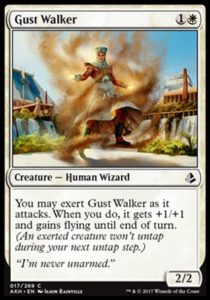
Fun Police
Any cube designer worth their salt will tell you that a balanced format requires powerful fun police. If everyone can get away with doing shenanigans, formats devolve into people ignoring each other and playing haymakers until someone dies from it. Aggressive decks police their fun by forcing people to play honest, interactive, creature-based (or killing) Magic.
Everything I’ve heard and experienced about Amonkhet suggests that the aggressive decks, particularly white-black and red-white, are very powerful. They’re not unbeatable, but they’re very strong. This is great! The format isn’t simply defined by the most powerful shenanigans and the shenanigans decks are more likely to be open because people will be drafting aggro.
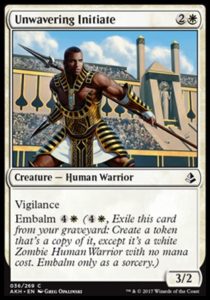
FUN Fun Police
Now, I recognize the value of having powerful fun police, but that doesn’t mean I have to like it. I generally don’t enjoy playing mono-red aggro in cube because while I enjoy winning, I don’t love how it plays out. However, the aggressive decks in Amonkhet have their own slew of shenanigans, from W/B zombie tribal to W/B/G -1/-1 counters, from R/B heckbent to W/R/G exert. They play very differently, they have a slew of interesting choices, and honestly, they’re pretty fun shenanigans. I rarely have this much fun while fun policing, and I’m happy that Bolas has provided this bounty.
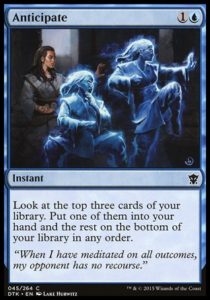
Amonkhet has been a breath of fresh air—well, probably sandy and mummy-smelling air, but you get the picture. I know that the past while has been a bit turbulent for Magic, but if Wizards of the Coast can design something as wonderful as Amonkhet Limited, they absolutely have my support and trust (not to mention the contents of my wallet). I’ve got my first dozen drafts in and couldn’t be more excited for the next three dozen. Here’s hoping you’re having at least half as much fun as I’ve been.
And, as always, thanks for reading.
—Zachary Barash
Zachary Barash is a New York City-based game designer. He learned Magic in 1994 and is still afraid of Living Wall (don’t click it! It’ll see you!). He’s two weeks away (!!!!) from receiving MFA in Game Design at NYU. After that, it’s back to designing for Kingdom Death: Monster.
His favorite card of the month is Hieroglyphic Illumination. It combines two underwhelming cards into something far greater than the sum of its parts, and that’s before considering all of the cycling and spells-matter shenanigans in Amonkhet.

